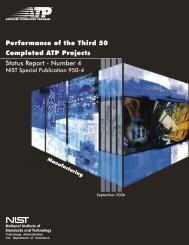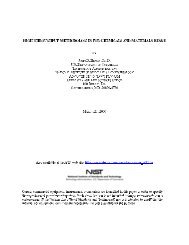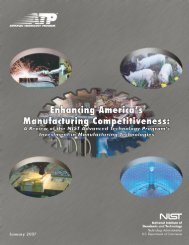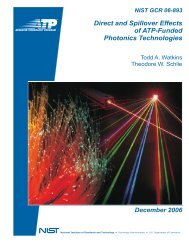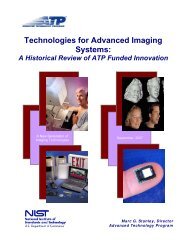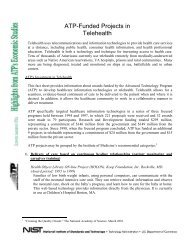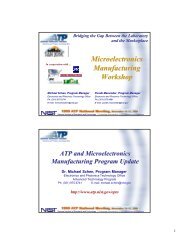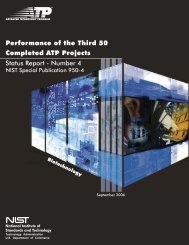ATP-Funded Green Process Technologies - NIST Advanced ...
ATP-Funded Green Process Technologies - NIST Advanced ...
ATP-Funded Green Process Technologies - NIST Advanced ...
Create successful ePaper yourself
Turn your PDF publications into a flip-book with our unique Google optimized e-Paper software.
The likely alternative situation, sometimes referred to as the “counterfactual<br />
scenario,” is the basis for gauging the additionality of <strong>ATP</strong> investments and<br />
documenting that <strong>ATP</strong> has been and continues to be a good steward of taxpayer<br />
dollars and is effective in generating substantial and measurable economic benefits<br />
that contribute to U.S. industrial competitiveness.<br />
Public and Private Benefits<br />
To evaluate the performance of <strong>ATP</strong>-funded technology projects, innovation benefits<br />
are documented for two classes of beneficiaries.<br />
• Economic benefits enjoyed by the innovating firms are considered private benefits.<br />
The innovating firm’s expectation of private benefits or profit contribution from<br />
new technologies is a necessary precondition for the firm’s continued efforts to<br />
complete remaining technical development tasks (after the successful completion of<br />
the <strong>ATP</strong>-funded project phase) and for undertaking subsequent commercialization<br />
and marketing efforts. Without commercialization, the economic and social<br />
benefits from <strong>ATP</strong>-funded technology projects could not be realized.<br />
• In contrast to private benefits, economic and social benefits arising from the <strong>ATP</strong>funded<br />
technologies and enjoyed by downstream industrial firms and end users of<br />
industrial products are considered public benefits. In microeconomic terms, public<br />
benefits represent “spillover” phenomena, where the degree of spillover represents<br />
that portion of total benefits that the innovating firm is unable to capture for itself<br />
(Jaffe, 1996). As suggested by both the theoretical and empirical economics<br />
literature, total benefits from <strong>ATP</strong> investments can be expected to substantially<br />
exceed the magnitude of private benefits (Mansfield et al., 1977).<br />
Public benefits may “trickle down” from industrial customers of the innovating firm<br />
to end-use customers. Other public benefits have a public-goods quality that society<br />
at large can enjoy directly. Examples of public-goods-type benefits from green process<br />
technologies include the following:<br />
• Reduced harmful environmental emissions<br />
• Conservation of scarce energy resources<br />
• Knowledge diffusion about new technologies<br />
Attribution of Benefits to <strong>ATP</strong><br />
The central objective of conducting detailed case studies and several mini-studies is to<br />
gauge the programmatic impact of rigorously screened and well-timed <strong>ATP</strong><br />
investments.<br />
At the same time, it is important to identify funding contributions from other public<br />
sources and to provide a fair and objective assessment of the portion of public<br />
10 <strong>ATP</strong>-FUNDED GREEN PROCESS TECHNOLOGIES



